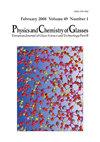Optical and electron paramagnetic resonance studies of VO2+ doped mixed alkali–alkaline earth oxide borate glass system
IF 0.3
4区 材料科学
Q4 CHEMISTRY, PHYSICAL
Physics and Chemistry of Glasses-European Journal of Glass Science and Technology Part B
Pub Date : 2022-01-01
DOI:10.13036/17533562.63.2.78
引用次数: 0
Abstract
Glasses with the composition xK2O–(25−x) Li2O–12·5BaO–12·5MgO–48B2O3–2V2O5 (0≤x≤20) were prepared by the melt quenching method. The mixed alkali effect (MAE) has been investigated in the glass system through density, molar volume, optical absorption and EPR studies. VO2+ ions were used as the spin probes. From the optical absorption studies the values of the optical band gap (Eopt) for indirect transitions and the Urbarch energy (∆E) were evaluated. The values of Eopt, ∆E and density exhibited nonlinear behaviour with the variation of Li2O content, which may be attributed to the mixed alkali effect. The EPR spectra have structures which are characteristic of a hyperfine interaction arising from an unpaired electron with the 51V nucleus and it builds up in intensity as x increases. The spin-Hamiltonian parameters were evaluated from the EPR spectra. For x=0 mol%, the EPR spectrum was found to be more intense and well resolved. The variation of g‖ versus A‖ and N versus 1/x as a function of Li2O content was found to be nonlinear, which may be due to the mixed alkali effect. The results obtained were explained.掺VO2+混合碱-碱土氧化硼酸盐玻璃体系的光学和电子顺磁共振研究
采用熔体淬火法制备了xK2O -(25−x) Li2O-12·5BaO-12·5MgO-48B2O3-2V2O5(0≤x≤20)的玻璃。通过密度、摩尔体积、光吸收和EPR研究了玻璃体系中的混合碱效应。用VO2+离子作为自旋探针。通过光吸收研究,计算了间接跃迁的光学带隙(Eopt)和厄巴奇能(∆E)。Eopt、∆E和密度随Li2O含量的变化呈非线性变化,这可能与混合碱效应有关。EPR谱具有由未配对电子与51V核产生的超精细相互作用的特征,并且随着x的增加而增强。利用EPR谱计算了自旋哈密顿参数。当x=0 mol%时,EPR光谱更强,分辨率更高。g‖对A‖和N对1/x随Li2O含量的变化是非线性的,这可能是由于混合碱的影响。对所得结果进行了说明。
本文章由计算机程序翻译,如有差异,请以英文原文为准。
求助全文
约1分钟内获得全文
求助全文
来源期刊

CiteScore
0.70
自引率
33.30%
发文量
0
审稿时长
1 months
期刊介绍:
Physics and Chemistry of Glasses accepts papers of a more purely scientific interest concerned with glasses and their structure or properties. Thus the subject of a paper will normally determine the journal in which it will be published.
 求助内容:
求助内容: 应助结果提醒方式:
应助结果提醒方式:


